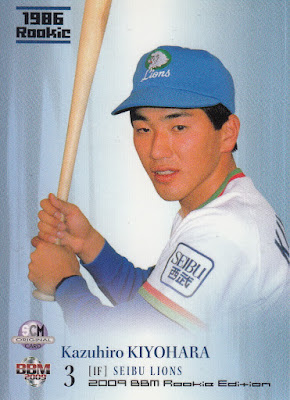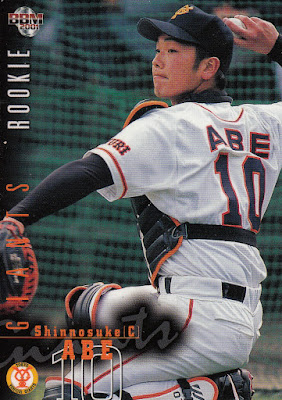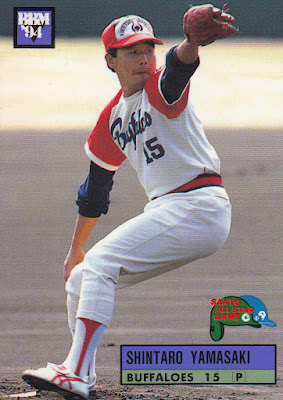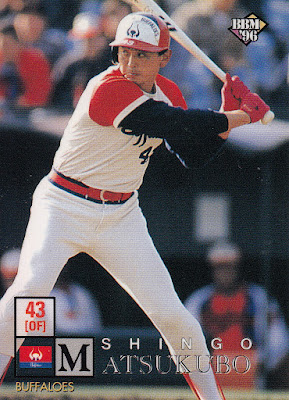2017 BBM 2nd Version Set Summary
Size: 313 cards (cards numbered 337-600, then 13 cards of "Ceremonial First Pitch" subset are separately numbered FP01-FP13 and 36 cards for "Cross Squall" subset are separately numbered CS37-CS72)
Cards Per Team: 19 (team card + 18 players)
Team Card Theme: Mascots
Number Of Leader Cards: N/A
Checklists: 0
Subsets: 1st Version Update (36), Ceremonial First Pitch (13), Cross Squall (36)
Inserts: Bright Stars
Memorabilia Cards: Jersey cards for Seigi Tanaka and Chihiya Sasaki along with a "Combination" jersey card with both of them. The single jersey cards are numbered to 200 while the "Combination" card is numbered to 10. There's a patch version of the Jersey cards that are numbered to 20 (not sure if there's a patch version of the combination card). There are autograph cards of many players available as well as autographed version of many of the Ceremonial First Pitch cards.
Parallels: 12 regular player cards as well as the Marines team card and the Ami Inamura Ceremonial First Pitch card have a "secret" alternate photo version. 10 of the 1st Version Update cards and 54 of the regular player cards have five different facsimile autograph parallels - silver (unnumbered), gold (numbered to 100), hologram (numbered to 50), red (numbered to 25) and green (numbered to 10). There are two parallels for the "Cross Squall" cards - one is numbered to 100 and the other is a "1 of 1". There are two parallels for the Ceremonial First Pitch cards one numbered to 100 and the other to 50. I think there are two different parallels for the Bright Stars insert cards - one numbered to 150 and the other numbered to 50.
Notable Rookies: None
Man, not having the detail promo sheets for the set from Sports Card Magazine really makes it harder to list what parallels there are. I'm basically searching Yahoo! Japan Auctions to see what's there.
I've mentioned this before but I feel like I really don't have much to say anymore about BBM's flagship sets. Especially since the sets have pretty much been the same the past three years.
Like this year's 1st Version set, the big new thing in this year's 2nd Version set is the "secret" version of 12 of the player cards (1 per team). The "secret" version features a different photo than the regular version of the card. BBM extended this a little bit more for this set (although nowhere near as much as Epoch has in their team sets this year) by adding a "secret" version of the Marines team card that shows their new lantern fish mascot rather than Mar-Kun and a "secret" version of Ami Inamura's Ceremonial First Pitch card. So there are a total of 14 "secret" versions. The players featured are different than the 12 players from the 1st Version set but still feature a lot of the big names in NPB - Shinnosuke Abe, Seiya Suzuki, Yuki Yanagida, Yoshio Itoi and T-Okada. I don't have the "secret" versions yet but I swiped images off of Yahoo! Japan Auctions to show the normal and "secret"versions of the cards of Seiya Suzuki, the Marines and Ami Inamura:
 |
| #498 |
 |
| #591 |
 |
| #FP05 |
The main downside of the "secret" versions of the cards is that BBM is saving their interesting photos for them so the bulk of the cards suffers from my usual complaint - too many photos of pitchers pitching and batters batting. There are a few photos of fielders fielding and runners running but almost no candids. As usual the photos are attractive and the card design isn't bad but it just gets a bit monotonous. Here's a couple examples:
 |
| #411 |
 |
| #572 |
 |
| #532 |
The one exception to this is Kazuo Matsui's card, which shows him celebrating his 200th career NPB home run back on April 22nd:
 |
| #461 |
The last two years BBM's put a card of Shohei Ohtani batting in the 1st Version Update subset of the 2nd Version set. This time they gave him a "regular" 2nd Version card instead - I'm kind of wondering if it's because he had a "secret" version card in 1st Version showing him batting.
 |
| #388 |
I will also voice my usual complaint that the 1st and 2nd Version photos for a couple players are almost identical:
 |
| 2017 BBM 1st Version #031 (left) and 2nd Version #393 (right) |
 |
| 2017 BBM 1st Version #171 (top) & 2nd Version #486 (bottom) |
Here's what the back of the cards looks like - stats are through May 28th:
 |
| #561 (Hirofumi Yamanaka) |
If I've counted right there are 32 players with a "regular" 2nd Version card who did not have a 1st Version card. They are Tomohisa Ohtani and Tatsuya Uchi of the Marines; Atsushi Fujii, Jordan Norberto, Yu Satoh and Daisuke Sobue; Takuya Kai and Hiroaki Takaya of the Hawks; Kentaro Kuwahara, Masahiro Nakatani and Ryutaro Umeno of the Tigers; Yuta Nakamura, Ren Nakata and Ryoma Nishikawa of the Carp; Yohei Kagiya, Luis Mendoza and Hiroshi Urano of the Fighters; Hikaru Itoh, Koji Ohshiro and Kengo Takeda of the Buffaloes; Fumikazu Kimura, Shuta Tonosaki and Naoto Watanabe of the Lions; Japhet Amador and Hiroyuki Fukuyama of the Eagles; Takahiro Araki and Ryota Yachi of the Swallows, Yoshiki Sunada of the Baystars; and Miles Mikolas, Ryosuke Miyaguni, Kan Ohtake and Soichiro Tateoka of the Giants. Since there's no overlap between these guys and the 36 players in the "1st Version Update" subset, the 2nd Version set has added cards for 68 players who didn't have one in 1st Version.
I did notice one oddity about someone who's not in the set - Seigi Tanaka of the Hawks. So one of the two players who has a jersey card in the set doesn't have a "regular" card in it.
The "1st Version Update" subset contains cards for 36 players (3 pet team) that for whatever reason did not appear in the 1st Version set. This includes both late signing players like Munenori Kawasaki, Alfredo Despaigne and Rafael Dolis and just players who I guess BBM just didn't think were significant enough to be in the earlier set like Hitoki Iwase, Takumi Akiyama and Kazuki Yabuta. As I say every time I write about this set, I have no idea what makes BBM decide to put a player in this subset rather than give them a "regular" card - I suspect it's random to some extent.
 |
| #365 |
 |
| #358 |
Most of the players I had noted about being missing in the 1st Version set back at the beginning of July are included in this set. Really the only player who was with their team before the beginning of June that I mentioned who is not in the set is Ramiro Pena of the Carp. None of the players I mentioned who signed with their NPB teams after the beginning of June (Chris Marrero, Xavier Batista) are in the set - as I said in that post I'm really hoping BBM does another Fusion set this fall with an extended "1st Version Update" subset.
The theme of the team cards is mascots. Again.
 |
| #594 |
The 2nd Version set has the second half of the "Cross Squall" cross-set subset. There are 36 cards (3 per team) and they are numbered CS37 to CS72. Shohei Ohtani had a card in the 1st Version's half of this subset showing him pitching and appears in this half batting. (I would show his card but the Fighters cards from this subset were inexplicably left out of the set I got off Yahoo! Japan Auctions and I'm still working the issue with Noppin.)
 |
| #CS47 |
The last subset for the set is the annual "Ceremonial First Pitch" set. This time around it's 13 cards of various celebrities throwing out the first pitch before games. The cards are numbered separately than the rest of the set - FP01 to FP13. The subset includes actress
Haruka Christine, model
Nicole Fujita, the aforementioned and ubiquitous
Ami Inamura, model/actress
Anna Ishibashi, actress
Yukiko Kawabe,
Tacoyaki Rainbow singer Saki Kiyoi, politician (and first female governor of Tokyo)
Yuriko Koike, actress
Ayano Kudo, Morning Musume singer
Maria Makino, actress/model(?) Chiaki Taguchi, actress/model
Rena Takeda, actress
Chika Yamane and actress
Miyu Yoshimoto.
 |
| #FP02 |
As always you can see all the cards (including parallels, insets and "secret" versions) at
Jambalaya.










































